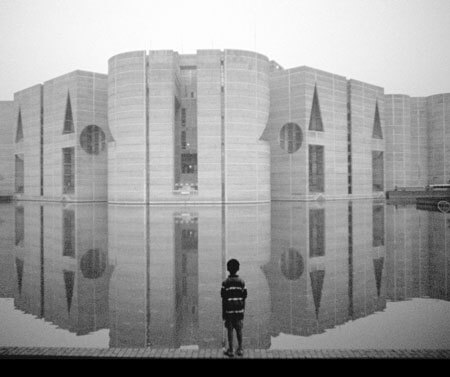A son searches for Louis I. Kahn, the architect and the man
Thomas Wolfe—who wrote “Look Homeward, Angel” and was always searching for his father and for himself—would have appreciated a documentary film called “My Architect” that’s runs for two weeks at Film Forum beginning November 12.
You may never have heard of Louis I. Kahn, who died in 1974, alone and broke in the men’s room of the architectural disaster known as Pennsylvania Station. But virtually every architect living or dead owes something of a debt to Louis Kahn, and in this questing, occasionally aggravating, 116-minute cinematic exploration by his son, a half-dozen headliners tell you why.
Philip Johnson: “How Lou ever got clients is a mystery. Artists don’t get clients… He was free compared to me.”
I.M. Pei: “He once told me: ‘Go to Scotland!’ He also said: ‘The best is yet to come’… I’m a little bit more patient, because I’m Chinese. I’ll [get insulted by a client or a situation and] come back another day. I don’t think Lou would do that… Three or four masterpieces [of Kahn’s] are worth more than 56 successful buildings [by Pei]. Quality, not quantity.”
Frank Gehry: “Lou was a breath of fresh air in America.”
Robert A.M. Stern: “He didn’t know day from night… Was very unhappy at not being selected to design the John F. Kennedy Memorial Library… I don’t think he was always wanting to be a prince. I think he very much wanted to be a player.”
Moshe Safdie: “I’ll always carry the memory of the way he died, alone, unidentified.”
Edward Bacon, hard-headed Philadelphia city planner: “There’s not a shred of any way in which Lou influenced downtown Philadelphia… His ideas were totally insensitive, totally impractical… God damn it… If you have no responsibility for the larger things [and say things like]:‘Why can’t people leave their cars outside the city and walk instead?’”
Louis I. Kahn, to a master-class, in footage from the Museum of Modern Art: “You say to brick: ‘What do you want, brick?’ Brick says: ‘I like an arch.’ If you say: ‘Brick, you’re too expensive, how about a concrete lintel,’ Brick says: ‘I like brick.’”
B.V. Doshi, Bangladesh architect, standing before the vast red brick Capital Complex in Dhaka, Kahn’s one indisputable masterpiece, completed after his death: “Silence mattered to him. Light mattered to him…He has not come back — as yet. But he’s there. Watching. Waiting. And wishing.”
So who was the man whose body went unidentified and unclaimed for three days in 1974 because the address on the passport found in his pocket had been carefully X’d out? That was the final concealment, son Nathaniel is convinced, of a womanizing libertine who had even more concurrent families and wives––three––than Alec Guinness in “The Captain’s Paradise.”
Nathaniel, 11 years old when his father died, 39 now, has, with camera and crew, chased down everyone he could find who ever knew Louis Kahn, including the Philadelphia taxi drivers who remember how the guy loved the ladies, and the Bangladesh construction workers who cheerfully exclaim: “Ah, yes, Louis Farakhan!”
Filmmaker Kahn also hunts up and interviews the half-sisters he never knew, several strait–laced aunts, one of whom had conveyed a plea to Nathaniel’s mother-to-be, unmarried and pregnant at 32 (Kahn was 60) to get an abortion, and then illegitimate son Nathaniel puts on camera and cross-examines that mother––his own mother. At one instant, when he presses too hard and ineptly (“Didn’t you know what you were getting into?”), she brushes him off with a cool: “Oh, c’mon.” It is, for me, the telling moment of the movie.
He presses too hard elsewhere also. A long passage interviewing the troubled soul who witnessed (or says he witnessed) Kahn’s death in Penn Station could well have been cut, as could a meandering, tear-laden interview with the owner of a music barge designed by Kahn.
But what is not extraneous––what is very much to the point––is the characterization of Estonian-born Louis I. Kahn (and that wasn’t his real name either) as, in the words of one intimate: “Short and ugly and Jewish and having a bad voice” and a scarred face––in a field pretty much reserved in those days, in this country, for well-born, well-off white Protestants.
That too is why Louis Kahn, dreamer of dreams, friend of bricks and other pure materials, bigamist, begetter of children legitimate and otherwise, scratcher-out of addresses on passports, was, unfortunately for him, far more a prince than a player. He should have died in the old Pennsylvania Station, not the new one. He deserved that great architecture.


































